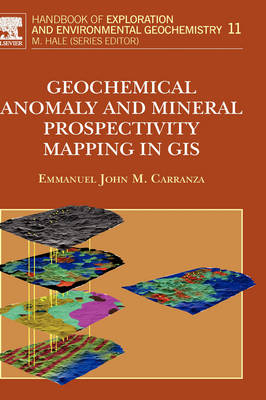
Geochemical Anomaly and Mineral Prospectivity Mapping in GIS
Seiten
2008
Elsevier Science Ltd (Verlag)
978-0-444-51325-0 (ISBN)
Elsevier Science Ltd (Verlag)
978-0-444-51325-0 (ISBN)
Documents and explains geochemical anomaly and mineral prospectivity mapping by using a geographic information system (GIS). This book reviews and couples the concepts of mapping geochemical anomalies and mineral prospectivity and spatial data models, management and operations in a GIS. It details methods in which GIS plays an important role.
Geochemical Anomaly and Mineral Prospectivity Mapping in GIS documents and explains, in three parts, geochemical anomaly and mineral prospectivity mapping by using a geographic information system (GIS). Part I reviews and couples the concepts of (a) mapping geochemical anomalies and mineral prospectivity and (b) spatial data models, management and operations in a GIS. Part II demonstrates GIS-aided and GIS-based techniques for analysis of robust thresholds in mapping of geochemical anomalies. Part III explains GIS-aided and GIS-based techniques for spatial data analysis and geo-information sybthesis for conceptual and predictive modeling of mineral prospectivity. Because methods of geochemical anomaly mapping and mineral potential mapping are highly specialized yet diverse, the book explains only methods in which GIS plays an important role. The book avoids using language and functional organization of particular commercial GIS software, but explains, where necessary, GIS functionality and spatial data structures appropriate to problems in geochemical anomaly mapping and mineral potential mapping. Because GIS-based methods of spatial data analysis and spatial data integration are quantitative, which can be complicated to non-numerate readers, the book simplifies explanations of mathematical concepts and their applications so that the methods demonstrated would be useful to professional geoscientists, to mineral explorationists and to research students in fields that involve analysis and integration of maps or spatial datasets. The book provides adequate illustrations for more thorough explanation of the various concepts.
Geochemical Anomaly and Mineral Prospectivity Mapping in GIS documents and explains, in three parts, geochemical anomaly and mineral prospectivity mapping by using a geographic information system (GIS). Part I reviews and couples the concepts of (a) mapping geochemical anomalies and mineral prospectivity and (b) spatial data models, management and operations in a GIS. Part II demonstrates GIS-aided and GIS-based techniques for analysis of robust thresholds in mapping of geochemical anomalies. Part III explains GIS-aided and GIS-based techniques for spatial data analysis and geo-information sybthesis for conceptual and predictive modeling of mineral prospectivity. Because methods of geochemical anomaly mapping and mineral potential mapping are highly specialized yet diverse, the book explains only methods in which GIS plays an important role. The book avoids using language and functional organization of particular commercial GIS software, but explains, where necessary, GIS functionality and spatial data structures appropriate to problems in geochemical anomaly mapping and mineral potential mapping. Because GIS-based methods of spatial data analysis and spatial data integration are quantitative, which can be complicated to non-numerate readers, the book simplifies explanations of mathematical concepts and their applications so that the methods demonstrated would be useful to professional geoscientists, to mineral explorationists and to research students in fields that involve analysis and integration of maps or spatial datasets. The book provides adequate illustrations for more thorough explanation of the various concepts.
PART I. MODELS IN MINERAL EXPLORATION AND GIS1. Predictive Modeling of Mineral Exploration Targets2. Spatial Data Models, Management and Operations
PART II. GEOCHEMICAL ANOMALY MAPPING3. Exploratory Analysis of Geochemical Anomalies4. Fractal Analysis of Geochemical Anomalies5. Catchment Basin Analysis of Stream Sediment Anomalies
PART III. MINERAL PROSPECTIVITY MAPPING6. Analysis of Geologic Controls of Mineral on Mineral Occurrence7. Knowledge-Driven Modeling of Mineral Prospectivity8. Data-Driven Modeling of Mineral Prospectivity
| Erscheint lt. Verlag | 26.11.2008 |
|---|---|
| Reihe/Serie | Handbook of Exploration and Environmental Geochemistry |
| Verlagsort | Oxford |
| Sprache | englisch |
| Gewicht | 800 g |
| Themenwelt | Naturwissenschaften ► Geowissenschaften ► Geologie |
| ISBN-10 | 0-444-51325-6 / 0444513256 |
| ISBN-13 | 978-0-444-51325-0 / 9780444513250 |
| Zustand | Neuware |
| Haben Sie eine Frage zum Produkt? |
Mehr entdecken
aus dem Bereich
aus dem Bereich


